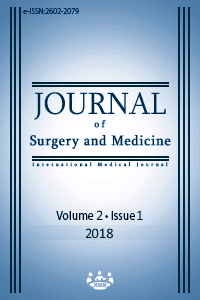Does combined antegrade and selective coronary graft cardioplegia reduce conduction defects in right coronary artery occluded patients?
Keywords:
Cardioplegia, Myocardial protection, Conduction disturbanceAbstract
Aim: Post coronary artery bypass grafting (CABG) procedure conduction disturbances may appear due to many reasons. In this particular study we compared postoperative cardiac rhythm disturbances in right coronary artery (RCA) occluded patients, which cardioplegia disturbed with antegrade aortic and continuous retrograde way versus antegrade plus continue right coronary graft.
Methods: A total of 104 patients with right coronary artery occlusion who underwent isolated CABG procedure between 2011 and 2017 were included. The number of female patients was 43 (41.4%). Left bundle branch, left branch hemi block, and left branch hemi block and 3rd degree atrioventricular (AV) blocks were evaluated in the early postoperative period.
Results: The mean age of patients was 55.54±4.42 years (range 46-65 years). There was no statistical difference among groups according to preoperative and intraoperative demographics. Postoperative rhythm disturbances were higher in Group 1 but there was no statistical difference. (Group 1: 9 patients and Group 2: 4 patients. p=0.378). Hospital stay and intensive care unit (ICU) stay had statistically significant difference among groups (Group 1 mean hospital stay was 7.40±1.31 days and Group 2 had mean 6.53±1.19 days p=0.026 and Group 1 mean ICU stay was days 2.20±0.67 and Group 2 had mean 1.87±0.72 days p=0.021).
Conclusion: We believe that continuous RCA-selective cardioplegia administration in addition to antegrade cardioplegia may be more successful in terms of prevention of postoperative rhythm disturbances in postoperative CABG applied patients.
Downloads
References
Gundry S, Sequeira A, Coughlin T, McLaughlin J. Postoperative conduction disturbances: a comparison of blood and crystalloid cardioplegia. Ann Thorac Surg 1989;47:38-90.
Caretta Q, Mercanti C, DeNardo D, Chiarotti F, Scibilia G, Reale A. et al. Ventricular conduction defects and atrial fibrillation after coronary artery bypass grafting. Multivariate analysis of preoperative, intraoperative and postoperative variables. Eur Heart J 1991;12:1107-11.
Pattison C, Dimitri W, Williams B. Persistent conduction disturbances following coronary artery bypass surgery: cold cardioplegic vs. intermittent ischemic arrest (32°C). Scand J Thorac Cardiovasc Surg 1991;25:151-4.
Mustonen P, Hippelainen M, Rehnberg S. Low myocardial temperatures are associated with postoperative conduction defects after coronary artery bypass surgery. Ann Chir Gynaecol 1995;84:44-50.
Aronson S, Jacobsohn E, Savage R, Albertucci M. The influence of collateral flow on the antegrade and retrograde distribution of cardioplegia in patients with an occluded right coronary artery. Anesthesiology 1998;89(5):1099-107.
Allen BS, Winkelmann JW, Hanafy H, Hartz RS, Bolling KS, Ham J, et al. Retrograde cardioplegia does not adequately perfuse the right ventricle. J Thorac Cardiovasc Surg 1995;109(6):1116-24.
Buckberg G. A proposed "solution" to the cardioplegic controversy. J Thorac Cardiovasc Surg 1979;77:803–15.
Soltesz EG, Laurence RG, De Grand AM, Cohn LH, Mihaljevic T, Frangioni JV. Image guided quantification of cardioplegia delivery during cardiac surgery. Heart Surg Forum 2007;10:E381-6.
Partington, M, Acar, C, Buckberg, G, Julia, P, Kofsky, E, and Bugyi, H. Studies of retrograde cardioplegia. I. Capillary blood flow distribution to myocardium supplied by open and occluded arteries. J Thorac Cardiovasc Surg 1989;97:605–12.
Gates, R, Laks, H, Drinkwater, DC, Pearl J, Zaragoza AM, Kaczer E, .et al. The microvascular distribution of cardioplegic solution in the piglet heart: retrograde versus antegrade delivery. J Thorac Cardiovasc Surg 1993;105:845–53.
Stirling, M.C, McClanahan, T.B, Schott, R.J Lynch MJ, Bolling SF, Kirsh MM. et al. Distribution of cardioplegic solution infused antegradely and retrogradely in normal canine hearts. J Thorac Cardiovasc Surg1989;98:1066–76.
Borger MA, Wei KS, Weisel RD, Ikonomidis JS, Rao V, Cohen G, et al. Myocardial perfusion during warm antegrade and retrograde cardioplegia: a contrast echo study. Ann Thorac Surg 1999;68(3):955-61.
Kulshrestha P, Rousou JA, Engelman RM, Flack JE 3rd, Deaton DW, Wait RB, et al. Does warm blood retrograde cardioplegia preserve right ventricular function? Ann Thorac Surg 2001;72(5):1572-5.
Ruengsakulrach P, Buxton BF.Anatomic and hemodynamic considerations influencing the efficiency of retrograde cardioplegia. Ann Thorac Surg 2001;71(4):1389-95.
Onem G, Sacar M, Baltalarli A, Ozcan AV, Gurses E, Sungurtekin H. Comparison of simultaneous antegrade/vein graft cardioplegia for myocardial protection. Adv in Therapy 2006;23:869-77.
Gursoy M, Bakuy V, Hatemi AC. Delivering Cardioplegia Beyond Totally Occluded Native Coronary Arteries Through the Saphenous Bypass Vein Graft: Is It Really a Protective Technique? Kosuyolu Kalp Derg 2012;15(3):100-4.
Mustonen P, Hippelainen M, Vanninen E, Rehnberg S, Tenhunen- Eskelinen M, et al. Significance of coronary artery bypass grafting associated conduction defects. Am J Cardiol 1996;81:558-63.
Tuzcu EM, Emre A, Goormastic M, Loop FD, Underwood DA. 1990. Incidence and prognostic significance of intraventricular conduction abnormalities after coronary bypass surgery. J Am Coll Cardiol 1990;16:607-10.
Kloner RA, Przklenk K, and Whittaker P. Deleterious effects of oxygen radicals in ischemia/reperfusion (Resolved and unresolved issues) Circ 1989;80(5):1115-23.
Ekim H, Yilmaz YK, Ekim M. Izotermik hiperkalemik kan kardiyoplejisinin myokard korunmasında önemi. Bozok Tıp Derg 2015;5(2):56-64.
Caspi J, Ammar R, Elami A, Safadi T, Merin G. Frequency and significance of complete atrioventricular block after coronary artery bypass grafting. Am J Cardiol 1989;63:526-9.
Seitelberger R, Wild T, Serbecic N, Schwarzacher S, Ploner M, Lassnigg A. et al. Significance of right bundle branch block in the diagnosis of myocardial ischemia in patients undergoing coronary artery bypass grafting. Eur J Cardiothorac Surg 2000;18:187-93.
Pehkonen EJ, Honkonen EL, Makynen PJ, Kataja MJ, Tarkka MR. Conduction disturbances after different blood cardioplegia modes in coronary artery bypass grafting. Including comparison with an earlier patient series. Scand J Thorac Cardiovasc Surg 1996;30:149-55.
Ueyama K, Jones JW, Ramchandani M, Beall AC, Thornby JI. Clinical variables influencing the appearance of right bundle branch block after cardiac surgery. Cardiovasc Surg 1997;5:574-8.
Mosseri M, Meir G, Lotan C, Hasin Y, Applebaum A, Rosenheck S, et al. Coronary pathology predicts conduction disturbances after coronary artery bypass grafting. Ann Thorac Surg 1991;51:248-52.
Downloads
- 3110 2909
Published
Issue
Section
How to Cite
License
Copyright (c) 2018 Oğuz Uğur, Mehmet Kalender, Hayat Gökmengil, Hakan Bingöl
This work is licensed under a Creative Commons Attribution-NonCommercial-NoDerivatives 4.0 International License.
















